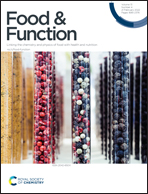Anti-inflammatory activity of peptides derived from millet bran in vitro and in vivo
Abstract
Various food-derived bioactive peptides have been found with potential anti-inflammatory effects. Millet bran peptide is a food-derived bioactive peptide extracted from millet bran, a by-product of millet processing. In this study, the anti-inflammatory effect of millet bran peptides was investigated. A lipopolysaccharide (LPS)-induced RAW264.7 cell and an animal experiment model were established to test the anti-inflammatory activity of millet bran peptides in vitro. As indicated by the results, millet bran peptides could significantly reduce the levels of inflammatory factors, including tumor necrosis factor-α (TNF-α), interleukin-1β (IL-1β) and prostaglandin E2 (PGE2), in the LPS-induced RAW264.7 cell. As demonstrated by the animal experiment results, millet bran peptides could mitigate the inflammation of spontaneously hypertensive rats (SHRs). According to the western blotting results, millet bran peptides reduced the phosphorylation level of an extracellular signal-related kinase (ERK), I Kappa B (IKB), p65, and p38 of LPS-induced RAW264.7 cells. As indicated by 16S rDNA sequencing analysis results, millet bran peptides could modify the composition of intestinal microbes. In brief, millet bran peptides could have anti-inflammatory activities in vivo and in vitro and mitigate the inflammation of LPS-induced RAW264.7 cells by regulating the signaling pathways of nuclear factor-κB (NF-κB) and mitogen-activated protein kinase (MAPK). The above research has laid a theoretical basis for the application of plant-derived peptides in health food.



 Please wait while we load your content...
Please wait while we load your content...